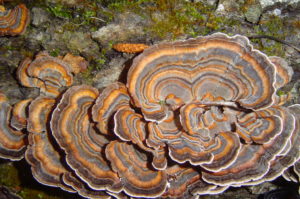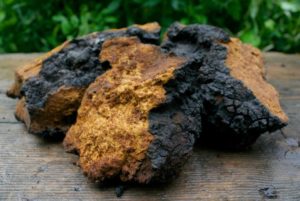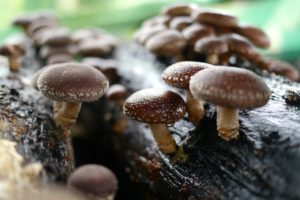Exotic Mushrooms are usually the most rare or interesting Fungi, but lets break it down a little further. “Exotic” can mean many things. Most literally, it refers to something from somewhere else, but the word carries such a connotation of excitement and glamour, that it also gets attached to things that are exciting, rare, or both, even if they are literally growing in your own back yard.
Like a mushroom.
Some of the mushrooms on this list might be easy to find if you know how to forage (depending on where you live), but you won’t find them in a grocery store. Others may appear in a few specialty grocery stores, but they’re imported, literally from somewhere else. And if some of these don’t seem all that exotic to you, it could be that your backyard is the “somewhere else” other people get these mushrooms from! If you’re out looking and fine one of these mushrooms listed below, bust out your favorite knife and put it in your bag as fast as possible!
The Top 16 Exotic Mushrooms
Lion’s Mane

The lion’s mane mushroom (Hericium erinaceus) is only the best-known of a small group of large, edible species in the same genus, all of which taste remarkably like crab meat—it can be used as a substitute in recipes—and all of which certainly look exotic. Lion’s mane itself is shaped like a short, thick club covered with soft spines. Fans of Star Trek can get the right idea by imagining a white or yellowish tribble. The other Hericiums look similar except they branch. Spine length varies with species, too. Surprisingly, the spines aren’t noticeable in the mouth. Not only are Hericiums delicious, but preliminary research suggests they may be useful for treating a whole range of maladies, including neurological problems. Lions Mane are popular among growers, specifically using a grow bag method.
Lions Mane tastes great but has better benefits as a supplement. Here is the Best Lions Mane Supplement on the Market.
Turkey Tail

Turkey tail (Trametes versicolor) does resemble a tiny version of the spread tail of a displaying tom turkey—fan-shaped with bands of multiple colors. It grows from tree stumps and provide a way of roughly aging the death of the tree; turkey tail never fruits from a stump cut less than three years earlier. Although turkey tail is not palatable, due to its woody, papery texture, it is a traditional part of folk medicine, and some studies at least support the effectiveness of its use.
Turkey Tail isn’t edible. It’s best taken as a supplement. Here is the Best Turkey Tail Supplement on the Market.
Cordyceps

Cordyceps (Cordyceps sp.) is often sold dried, looking like a shriveled finger of tissue growing out of a dead caterpillar. There’s a reason for that; some cordyceps species do kill and then grow out of caterpillars. These fungi are sold, not for food, but for their reputed medicinal value—which is supported by some scientific research. There are multiple cordyceps species in use. They vary dramatically in price. Practitioners disagree on whether and how they vary in medicinal value. Cordyceps Sinensis is also widely regarded as the most expensive mushroom in the world.
Cordyceps isn’t edible unless processed into a Supplement. This is the Best Cordyceps on the Market.
Chaga

Chaga (Inonotus obliquus) does not look like a mushroom. It looks like a partially-burnt growth on the side of a birch tree and is easy to confuse with other lumpy growths that trees get. It’s not edible, due to its very tough texture, but can be made into a tea reputed to have powerful medicinal benefits (like being an adaptogen)—claims beginning to be backed up by research.
Chaga is also inedible. It’s best to take it along with other mushroom supplements. Here is my favorite Mushroom Blend containing Chaga.
Reishi

Reishi (Ganoderma lingzhi) is another tough, unpalatable species widely considered a cure-all. Scientific research is supporting some medicinal uses, but also revealing that reishi can be significantly toxic under some circumstances. Another cause for confusion is that until recently, reishi was thought to grow across much of the world—now it’s known that the Asian species traditionally used in medicine is limited to Asia, and that other places have related but different species. Most users assume that all the species in the group, or even all Ganodermas, are interchangeable—equally safe and equally effective as medicine, and all should be treated simply as reishi. There is no reason to suppose they are right; closely-related mushrooms can be biochemically very distinct.
Reishi is best taken along with other Mushrooms. Here is my favorite Mushroom Blend containing Reishi.
Oyster Mushrooms

The oysters (Pleurotus sp.) are a large group of popular edible mushrooms, mostly with a mild flavor and a somewhat delicate texture. Most have a large, fan-shaped cap on a short stem that attaches on the side, like the handle of a fry-pan. Some species have the more familiar arrangement, a longer stem attached to the center of the cap. Most oysters are whitish or grayish, so that chunks of them on a plate look a little like those other oysters, the kind that live in the sea, but there are pink, blue, and yellow varieties, too.
Oyster mushrooms are easy to grow and so are popular with beginner mushroom-growing hobbyists, specifically using grow kits. Research suggests a range of possible medicinal uses, at least for some oyster species (they aren’t interchangeable).
Morel

The morels (Morchella sp.) are a large genus of mushrooms that are not only exotic-looking, they are also very hard to find—because the people who do find them keep the locations secret. The thing is, morels are delicious. There are people who categorize all edible fungi in just two groups: morels and then all other edible wild mushrooms.
All morels have a thick, hollow stem with a narrow cap on top somewhat like a thimble on a finger. Instead of gills below the cap there are pits in the cap’s outer surface that produce spores. Color, size, and proportion depend on species. All morels are edible, but there are several similar-looking groups, such as false morels and early morels, whose safety as food is hotly debated, so be sure to use a grow book or field guide when out looking for morels!
Maitake

Maitake is the Japanese name for (Grifola frondosa). The same mushroom also has an English name, hen-of-the-woods, though that can cause confusion with the very different chicken-of-the-woods. By any name, this is a very large mushroom consisting of many gray leaf-like or feather-like brackets on a central mass. A single specimen is enough for several meals. A good recipe involves pan-frying chopped maitake in oil or butter with garlic, turmeric, and pepper, then melting in cheese. Serve with pasta.
Chanterelle

The chanterelles (mostly Cantharellus sp., but also Craterellus and Gomphus sp.) are shaped like trumpets (except usually the top is flat, not hollow like a trumpet bell) with wrinkles or veins, rather than gills, on the outer surface. Depending on species, they may be large or small, or any of several different colors. Some chanterelle species vary so much that they have more than one common name. In other cases, multiple species look so similar that they all have the same common names. Ask for a list of all the chanterelle species, and a scientist will give you a completely different list than a chef will. Both will likely agree that chanterelles are delicious.
Chicken-of-the-Woods

Chicken-of-the-woods (Laetiporus sulphureus) is the most famous of a group of large, mostly-edible mushrooms that share a shelf-like shape, pores on the underside rather than gills, and usually an orangish or pinkish color. The group was, until relatively recently, thought to all be a single species. Not all of them have common names, yet, and some people use “chicken-of-the-woods” for the whole group.
Chicken is one of those mushroom groups that are generally recognized as edible while making some people quite ill. Nobody knows why. Human sensitivities or allergies are the most likely culprit, but it’s possible that some species are more toxic than others, it’s just unclear which because few people are sure which chicken they ate. Similarly, research suggests some possible medicinal benefits, but it’s not clear which species the researchers used. What is known is that most chicken species taste excellent and, indeed, a little like those chickens with feathers in flavor.
Shiitake

The shiitake (Lentinula edodes) is an Asian species that is now widely cultivated, including in the United States. It’s available either fresh or dried, usually in health food stores or Asian groceries. The shiitake doesn’t look all that exotic—it has the familiar toadstool shape, complete with gills—but its texture is firmer and chewier than your standard button mushroom, and its flavor is lighter, less “mushroomy,” sometimes almost perfumed. A little-known culinary trick is to freeze shiitakes, then defrost them before cooking in order to alter their texture. Treated thus, they make a great substitute for shellfish in chowder.
Enokitake

Enokitake (Flammulina velutipes), also sometimes called enoki mushroom, has a double identity. Growing wild, the species produces unremarkable-looking, brownish fruiting bodies, but grown in the dark with restricted airflow, the mushrooms become very long and thin with a very small cap and a whitish color. The unusual color, taste, and texture make cultivated enokitake a delicacy.
Beech Mushroom

The beech mushroom (Hypsizygus tesselatus) comes in two very different varieties: white beech is mild and slightly sweet; brown beech is savory and slightly bitter. There are also hybrids between the two. It’s also worth knowing that the Japanese name, hon shimeji, also refers to a similar but unrelated species. It’s called “beech” in English because beech trees are the favorite food of the fungus.
Both varieties of beech mushroom are delicious, healthy food, though they do well in different recipes. Preliminary research also suggests medicinal value.
Nameko

Nameko (Pholiota microspora), sometimes called the butterscotch mushroom, for its color, is a very popular culinary item across Asia, though it’s not common table fare in Europe or North America. Its claim to fame is is gelatinous outer layer, the sort of thing people either love deeply or cannot stand.
Wood Ear

Wood ear does, in fact, look a lot like brown human ears. They grow from dead or dying trees, and despite—or perhaps because of—their rubbery texture, they are very popular table fare in parts of Asia. There are actually several closely-related species (Auricularia sp.) called “wood ear” and used in recipes in very similar ways. All of them are reputed to have a range of medical benefits as well as a delicate flavor and the ability to absorb the flavors of the other foods they are cooked with.
Bicolor Bolete

The bicolor bolete (Baorangia bicolor) is well-named: a bolete is any of a group of classically toadstool-shaped mushrooms with a layer of pores under the cap instead of gills, and this bolete has two colors. The pore surface is yellow but bruises blue, while the rest of the mushroom is usually red. There are exceptions, though, as the species is quite variable. Adding to the confusion, there are several close look-alikes. The mushroom is edible and has a strong, robust taste that pairs well with red meat. Curiously, the taxonomy of this species is still very much in flux.


